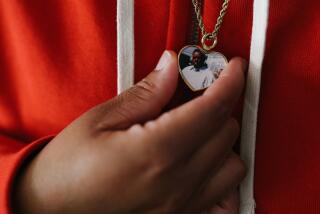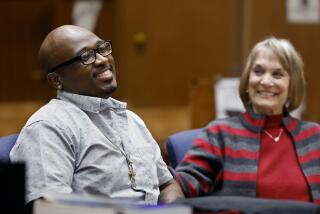Herman Wallace dies at 71; ex-inmate held in solitary for 41 years
For most of the past 41 years, Herman Wallace was allowed to leave his 6-by-9-foot Louisiana prison cell for only an hour a day a few times a week. He foresaw no end to the hours and days of his solitary confinement.
Convicted in the fatal 1972 stabbing of a prison guard, Wallace maintained his innocence and used his time behind bars to draw attention to abusive prison conditions. His legal appeals brought his freedom last week when a federal judge in Baton Rouge ruled his indictment had been unconstitutional because the grand jury excluded women.
Wallace had only a few days to savor the victory.
One of the “Angola 3,” whose long-term solitary confinement at Louisiana State Penitentiary in Angola became a cause celebre for prison reform advocates, Wallace died of complications of liver cancer Friday in New Orleans, his attorneys said. He was 71.
He had left solitary confinement for a prison hospital ward in June after the cancer was diagnosed. It took two orders from the federal judge and a threat of contempt before prison officials released him Oct. 1.
“He didn’t say a lot. He was exhausted,” said Ashley Wennerstrom, a friend of Wallace’s who was waiting for him when he got out. “We told him he was free. He nodded and he knew.”
Wallace was never told that the day before he died a grand jury in West Feliciana Parish, north of Baton Rouge, had re-indicted him in the prison guard’s death.
“Everybody says why indict a man who is about to die?” Dist. Atty. Sam D’Aquilla said in an interview Tuesday. “Because he was a murderer.”
Wallace entered the Angola prison in 1971 after a conviction for armed robbery. He was sent to solitary confinement in 1972 after he and two other inmates were accused of killing Brent Miller, a corrections officer. Of the three, two were convicted: Albert Woodfox in 1973 and Wallace in 1974. Their convictions were largely based on witness testimony from other prisoners, including a repeat rapist who was later found to have helped the prosecution in exchange for a reduced charge.
For nearly every hour of every day for four decades, Wallace and Woodfox were held in separate closet-sized cells. Their contact with the outside world was limited to occasional visits and phone calls. A few times a week they were allowed outdoors to exercise in a narrow pen.
“A lot of people will tell you it’s hard to imagine a worse thing one human being can do to another: lock you in a space the size of a small bathroom or closet and say that’s your home for 20 or 30 years,” said George Kendall, one of Wallace’s attorneys. “For some, it becomes very hard to leave the cell. You’re so desocialized you can’t live around other people. Both Herman and Albert Woodfox were determined that was not going to happen to them.”
Wallace filled his waking hours with reading and correspondence. With Woodfox and a third inmate in solitary confinement, Robert King, he also organized a chapter of the Black Panthers, the black nationalist group, and began mobilizing other African American inmates against brutal conditions inside Angola, including rampant prison rapes.
The Angola 3, as they came to be known, maintained that they were kept in solitary as payback for their political activities.
Amnesty International began campaigning for their release from isolation in the late 1990s. In 2008, U.S. Rep. John Conyers (D-Mich.) traveled to Angola to meet with the men and released a statement noting that they had been kept in isolation for “possibly a longer period than any other inmate in U.S. history.”
Attention continued to build with the 2010 documentary “In the Land of the Free,” directed by Vadim Jean, which focused on the Angola 3.
In the documentary, Leontine Verrett, the widow of Brent Miller, expressed doubts that Wallace and Woodfox were guilty of his death. “If they did not do this — and I believe that they didn’t — they have been living a nightmare,” she said.
Wallace was born in New Orleans on Oct. 13, 1941. One of eight children, he was raised by his mother, Edna Clark Williams, who worked in the Orleans Parish Prison. His five sisters survive him.
Wallace’s education ended in junior high, and he worked for a time as a welder. He had problems with the law, but no serious charges until his 1971 robbery conviction. Kendall said he confessed to the robbery, in which no one was harmed.
At Angola, Wallace went before review boards more than 100 times to appeal his placement in solitary. The board always told him that he remained in solitary because of the 1972 murder. “They did not look at more current behavior,” Kendall said.
“These hearings need to be meaningful, but in Louisiana there are no standards,” Kendall said. “Inmates have no idea what they need to do to graduate out of solitary. Herman said if there was only one thing he could do it was to make the hearings meaningful.”
Of the Angola 3, Woodfox remains in solitary. King was the most fortunate: He spent only 29 years in isolation. After his release from prison in 2001, he spoke out publicly about the need for prison reform, and it was at one such appearance that artist Jackie Sumell learned about him. She began writing to him and found he was articulate, funny, inquisitive and a prolific correspondent.
In 2003, when she was working for a master’s of fine arts at Stanford University, she decided to turn a class assignment to interview a faculty member about his home into a project revolving around her prison pen pal. She wrote to him with this question: What kind of house do you dream about after all your years in a cell?
The question floored him. “He was, like, ‘What?’” Sumell recalled Tuesday. “He said, ‘I don’t dream about a house. Are you joking?’”
But he gradually warmed to the project. Over the next four years, Sumell and Wallace exchanged 300 letters about his dream house. Sumell built a three-dimensional model that became a traveling art installation and the subject of a PBS documentary, “Herman’s House,” that aired in July.
The house, which Sumell hopes to build with donations, reveals much about Wallace’s hopes and fears. It has a garden filled with roses, delphiniums and other flowers favored by his supporters. It has a swimming pool with a large panther painted on its light green bottom — and a hot tub the same size as his cell.
He also asked for an underground bunker “so that if he was ever under attack he could burn the house down and escape safely,” Sumell said.
But at the same time Wallace envisioned the home as a community space with several guest rooms for visiting activists.
The project “expresses something different from the public perception of us prisoners,” Wallace told the New York Times in 2007. “We have dreams too.”
Wallace spent his final days at the home of Wennerstrom and her husband, Will Veatch, where dozens of friends and family made sure he was never without company.
“He was in and out of consciousness,” Wennerstrom said, “but he was able to speak a few words. The last thing he said before he died was, ‘I love you all.’”
More to Read
Start your day right
Sign up for Essential California for the L.A. Times biggest news, features and recommendations in your inbox six days a week.
You may occasionally receive promotional content from the Los Angeles Times.







